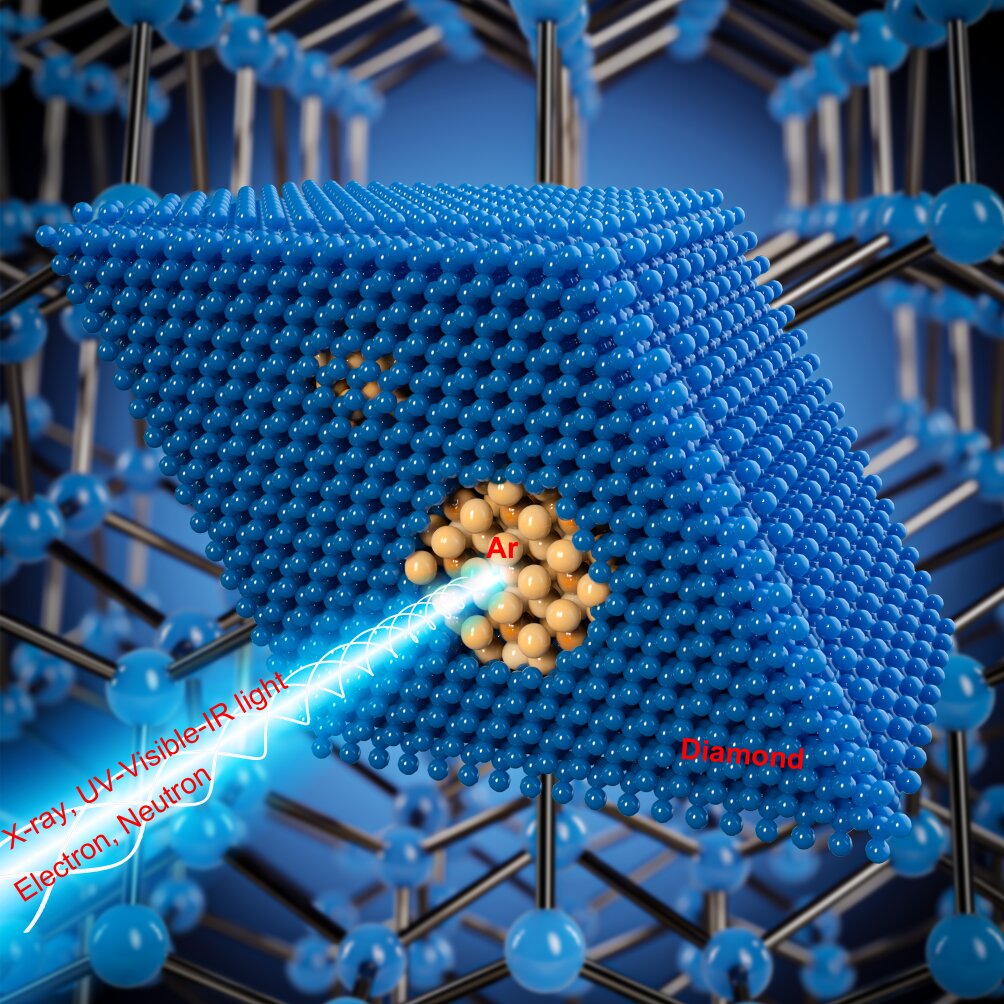by Center for High Pressure Science & Technology Advanced Research

Preservation of the high-pressure states of materials at ambient conditions is a long-sought-after goal for fundamental research and practical applications.
A team of scientists led by Drs. Zhidan (Denise) Zeng, Qiaoshi Zeng, and Ho-Kwang Mao from the Center for High Pressure Science and Technology Advanced Research (HPSTAR) and Prof. Wendy Mao from Stanford University report an innovative breakthrough where they were able to maintain the extraordinary properties of high-pressure materials in free-standing, nanostructured diamond capsules without the support of traditional bulky pressure vessels. Their work was recently published in Nature.
Modern technology is built upon access to materials with suitable physical and chemical properties that can be used to perform specific functions in various devices. Technological advances, therefore, are often dictated by the development of superior materials with desirable properties. High pressure can drastically alter or tune properties of all materials, thus providing a fertile ground for discovering novel materials with extremely favorable properties.
The caveat is, however, that the favorable properties often only exist under pressure when the sample remains in the bulky high-pressure vessel, limiting scientific investigation and potential applications. For the past century, scientists have tried to overcome this difficulty. They succeeded only in “quenchable” phases, where novel materials synthesized at high pressure retain their favorable properties after releasing pressure. A well-known example is the high-pressure conversion of ordinary carbon into diamond which is able to keep its brilliance and other exceptional properties after retrieving at ordinary pressures.
Unfortunately, such successful examples of quenchable phases are extremely rare, largely rendering high-pressure materials studies of only academic interest with little practical value in the ambient environment.
The HPSTAR and Stanford research group developed a novel approach that has demonstrated the ability to quench even tenuous gases and preserve their high-pressure properties. They compressed glassy carbon, an amorphous form of porous carbon, together with argon gas to 50 gigapascals—about 500,000 times atmospheric pressure, and heated the sample to 3,320 degrees Fahrenheit.
The glassy carbon that is initially impermeable to gases at ordinary conditions absorbs argon like a sponge at high pressures. The application of high pressure and temperature conditions converts the carbon into diamond and traps the now solid, high-pressure argon in its pores. The resulting sample that is retrieved at ambient conditions behaves like a nanocrystalline diamond composite with numerous isolated pores that represent like tiny diamond capsules filled with argon.
The residual pressure preserved in the argon by the diamond capsule is as high as 22 gigapascals—about 220 times the pressure at the bottom of the Mariana Trench. Better yet, the pressurized argon sample is sealed in by only nanometer-thick diamond skins allowing its extraordinary properties to be accessible by modern analytical probes that require near vacuum environments like electron microscopy.
“We directly observe many nanometer-sized high-pressure argon grains encapsulated in the nano-diamond matrix by high-resolution transmission electron microscopy; thus, we named them nanostructured diamond capsules (NDCs),” explained Dr. Denise Zhidan Zeng, the lead author of this work.
“One of the keys to realizing the concept of NDCs is choosing the right carbon precursor which is sp2 bonded and has pre-existing enclosed sample chambers. This is obviously by no means limited to glassy carbon. Therefore, a variety of crystalline, amorphous, and low-dimensional carbon allotropes could potentially be used as the precursor carbon as well, offering a wide range of capsule materials for optimization of the NDC process,” explained Zeng.
“Using multiple complementary diagnostic probes to obtain consistent results features the modern matter research. However, in-situ high-pressure studies have always required high-penetrating probes such as hard X-ray due to the thick high-pressure vessel walls involved. Therefore, many powerful and versatile probes, such as electron microscopy and vacuum ultraviolet to soft X-ray spectroscopy, that require a near vacuum environment, unfortunately, remain incompatible with high-pressure science and technology. This has severely hindered our efforts to understand many high-pressure materials,” said Dr. Qiaoshi Zeng.
“By synthesizing NDCs, we offer a general method to remove bulky pressure vessels while maintaining the high-pressure conditions and therefore the high-pressure behavior in our samples. We can now employ almost all the modern diagnostic probes to obtain detailed information of the atomic/electronic structures, compositions, and bonding nature of materials at high pressures inside NDCs, including various techniques based on transmission electron microscopy. We are excited about the possibility that an approach based on NDCs will bring high-pressure explorations on par with conventional condensed-matter investigations and applications.”
“Beyond the gases that we explored in our study, we also expect the concept of NDCs to be generally applicable to various solid samples,” said Prof. Wendy Mao.
“Moreover, NDC samples are in principle cumulative with the potential for unlimited, multiple syntheses, thus removing the limitation where high-pressure phenomena only exist in a tiny sample inside a large pressure chamber. Therefore, our work demonstrates the first, critical step toward the grand challenge of high-pressure materials applications for previously unquenchable phases.”
Capturing High Pressures in Diamond Capsules: Original Article


















